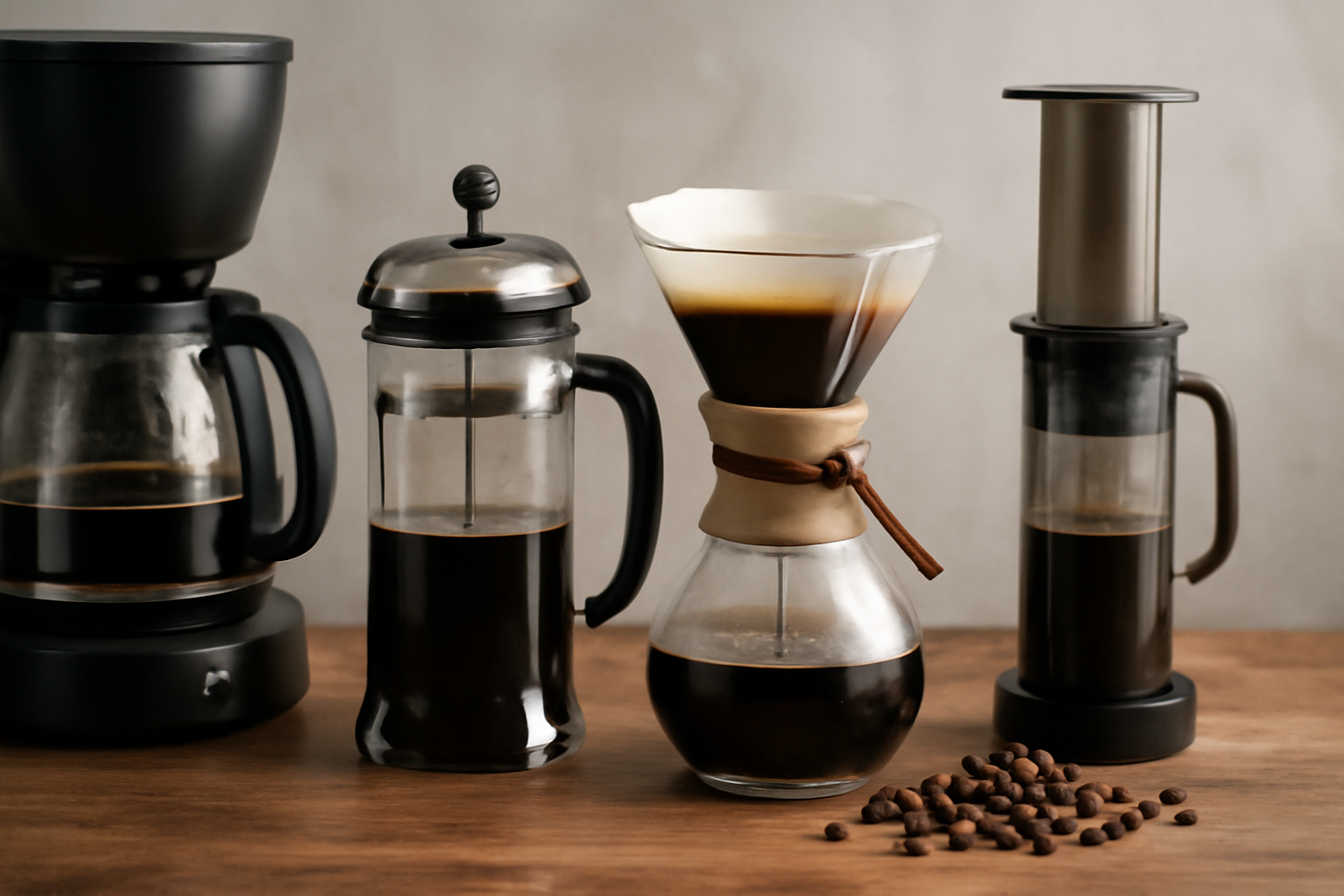For coffee lovers, there’s nothing quite as satisfying as brewing a perfect cup of coffee at home. But with so many brewing methods available, it can be overwhelming for beginners to know where to start. Whether you’ve recently discovered your love for coffee or you’re looking to upgrade your brewing skills, this guide will walk you through the best brewing methods for beginners.
In this article, we’ll cover the essential tools, techniques, and tips for brewing coffee at home, focusing on methods that are easy to learn and will elevate your coffee game.
1. The Basics of Brewing Coffee
Before diving into specific brewing methods, it’s essential to understand the basics of brewing coffee. The following factors will affect the quality of your brew, no matter which method you choose:
1.1. Coffee Beans
The foundation of any great cup of coffee starts with the beans. For beginners, it’s recommended to buy fresh, high-quality beans. There are two main types of coffee beans: Arabica and Robusta.
- Arabica Beans: Known for their smooth, complex flavors and mild acidity. They are the most popular choice for specialty coffee.
- Robusta Beans: These beans tend to have a stronger, bolder flavor and higher caffeine content. They are often used in espresso blends.
When buying coffee beans, aim for freshly roasted beans, as the flavor will degrade over time. If possible, grind your beans just before brewing to preserve their freshness and flavor.
1.2. Grind Size
The grind size is crucial to achieving the right extraction. A coarser grind allows for slower extraction, while a finer grind speeds up the process. Different brewing methods require different grind sizes:
- Coarse Grind: Used for methods like French press and cold brew.
- Medium Grind: Perfect for drip coffee makers and pour-over methods.
- Fine Grind: Required for espresso machines and Aeropress.
1.3. Water Quality and Temperature
Using clean, filtered water is crucial for the best-tasting coffee. Tap water with impurities or strong mineral flavors can negatively affect the flavor of your coffee.
The ideal brewing temperature for coffee is between 90-96°C (194-205°F). Too hot, and your coffee can become over-extracted and bitter; too cold, and the coffee will taste weak and under-extracted.
1.4. Coffee-to-Water Ratio
The right ratio of coffee to water is essential for a balanced brew. For beginners, the standard ratio is:
- 1:15 for drip coffee, pour-over, and French press. This means one part coffee to 15 parts water.
- 1:2 for espresso. This means one part coffee to two parts water.
Experiment with the ratio to find what works best for your taste.
2. Best Coffee Brewing Methods for Beginners
Now that you understand the basics, let’s dive into the most beginner-friendly brewing methods. These methods are easy to use, affordable, and deliver a satisfying cup of coffee.
2.1. Drip Coffee Maker
The drip coffee maker is one of the most popular and easiest methods for beginners. These machines automatically brew coffee by dripping hot water over a filter filled with ground coffee. Drip coffee makers are convenient and can brew multiple cups of coffee at once.
Pros:
- Easy to use
- Consistent results
- Brews multiple cups at once
Cons:
- Limited control over the brewing process
- Coffee may be weaker than espresso-based drinks
How to Brew:
- Fill the machine’s water reservoir with clean, filtered water.
- Place a filter in the basket and add your ground coffee.
- Turn on the machine and let it brew.
- Enjoy your fresh coffee once the brewing process is complete.
2.2. French Press
The French press, also known as a press pot or plunger pot, is a manual coffee brewing method that allows for full immersion of the coffee grounds in hot water. This results in a rich, full-bodied cup of coffee with a heavier texture.
Pros:
- Simple and affordable
- Full-bodied coffee with more flavor
- No need for paper filters
Cons:
- Requires a bit more attention and timing
- Can be messy to clean
How to Brew:
- Boil water and let it cool slightly (ideal temperature is around 95°C/203°F).
- Add coarsely ground coffee to the French press (a standard ratio is 1:15).
- Pour the hot water over the coffee grounds and stir.
- Place the lid on the French press and let it steep for 4 minutes.
- After steeping, slowly press down the plunger to separate the coffee grounds from the brewed coffee.
- Serve and enjoy.
2.3. Pour-Over Coffee
Pour-over coffee involves manually pouring hot water over coffee grounds in a filter. This method gives you more control over the brewing process and results in a clean, nuanced cup of coffee.
Pros:
- Full control over brewing time and temperature
- Clean, bright flavor
- Great for experimenting with different beans and techniques
Cons:
- Requires more attention and time
- Can be tricky for beginners to master
How to Brew:
- Set up your pour-over cone (such as a Chemex or Hario V60) with a filter.
- Boil water and let it cool slightly (around 90-96°C/194-205°F).
- Add ground coffee to the filter (use a medium grind).
- Begin pouring hot water over the coffee in small, circular motions. Start in the center and work your way out.
- Allow the coffee to bloom (expand) for about 30 seconds before continuing to pour.
- Continue pouring until all the water has passed through.
- Serve and enjoy.
2.4. Aeropress
The Aeropress is a compact and portable coffee maker that brews coffee by forcing water through coffee grounds under pressure. It’s a versatile and fast method that produces a strong, espresso-like coffee with minimal bitterness.
Pros:
- Fast brewing time (around 2 minutes)
- Portable and easy to clean
- Can make both espresso-style coffee and regular coffee
Cons:
- Requires some practice to perfect the brew
- Limited capacity (typically brews 1-2 cups at a time)
How to Brew:
- Place a filter in the Aeropress and rinse it with hot water.
- Add ground coffee to the Aeropress (use a medium-fine grind).
- Pour hot water over the coffee and stir to saturate the grounds.
- Attach the plunger and press down slowly for about 30 seconds.
- Serve and enjoy.
2.5. Cold Brew
Cold brew coffee is made by steeping coarsely ground coffee in cold water for an extended period (usually 12-24 hours). This method produces a smooth, low-acid coffee that’s perfect for iced coffee drinks.
Pros:
- Smooth, mellow flavor with low acidity
- Can be made in large batches
- Perfect for iced coffee lovers
Cons:
- Takes a long time to brew
- Not ideal for those who prefer hot coffee
How to Brew:
- Combine coarsely ground coffee and cold water in a jar or pitcher (use a 1:4 ratio).
- Stir to ensure the coffee grounds are fully saturated.
- Cover and let it steep in the fridge for 12-24 hours.
- Strain the coffee using a fine mesh strainer or coffee filter.
- Serve over ice, or dilute with milk or water for a smoother taste.
3. Conclusion
When you’re starting out in the world of coffee brewing, it’s essential to choose methods that are easy to master and provide great results. Whether you prefer the simplicity of a drip coffee maker, the full-bodied richness of French press, or the clean, bright flavors of pour-over coffee, there’s a brewing method for every taste. As you experiment and refine your skills, you’ll find the brewing methods that suit your preferences and lifestyle.
With these beginner-friendly methods, you can enjoy delicious, freshly brewed coffee at home without the need for expensive equipment or complex techniques. Start brewing, experiment, and enjoy the process of creating the perfect cup of coffee!

I’m an economist with 15 years of experience in strategic planning and a lifelong passion for wellness and natural living. As a self-learner, I created Herbalife Balance to share insights on healthy eating, mindful habits, and an active lifestyle. Tennis enthusiast and nature lover, I believe in balance as a path to well-being. Through this blog, I help others live healthier, more conscious lives.

